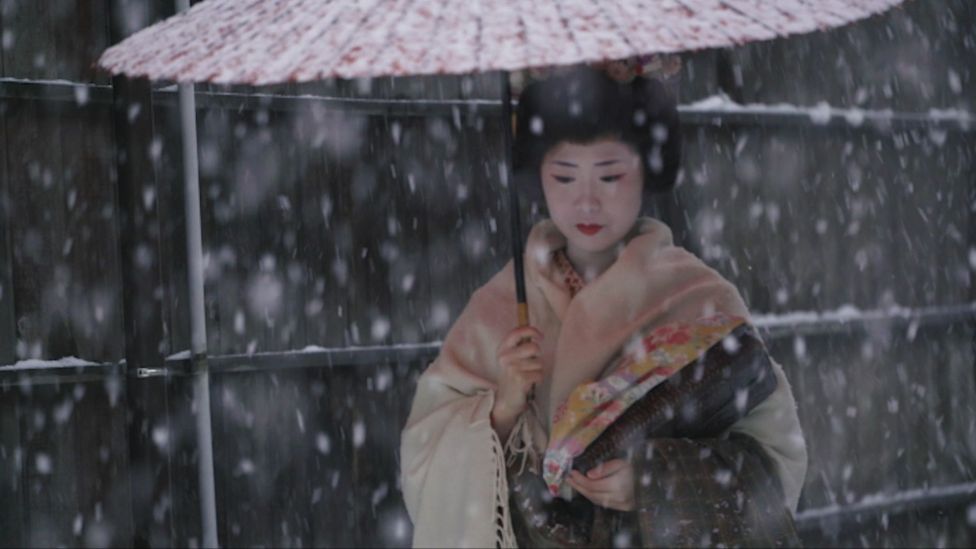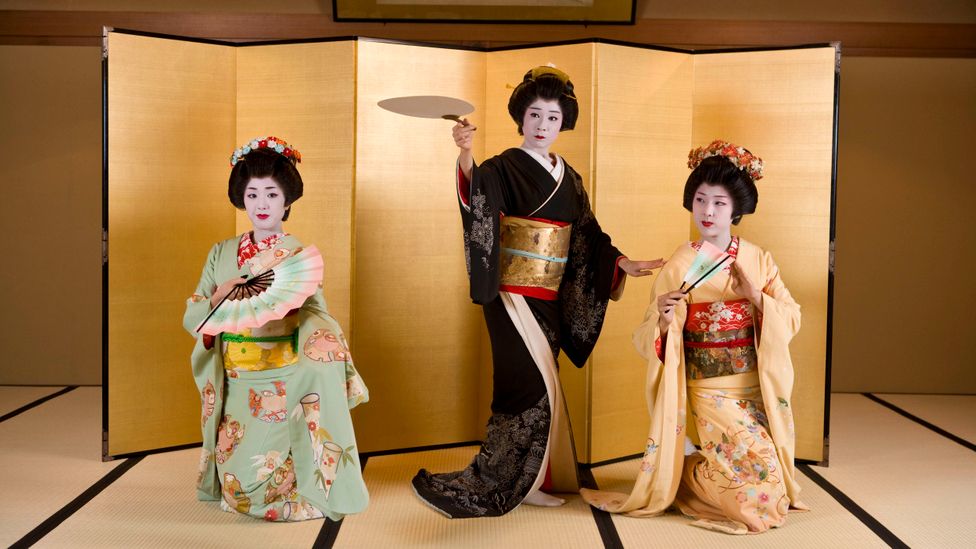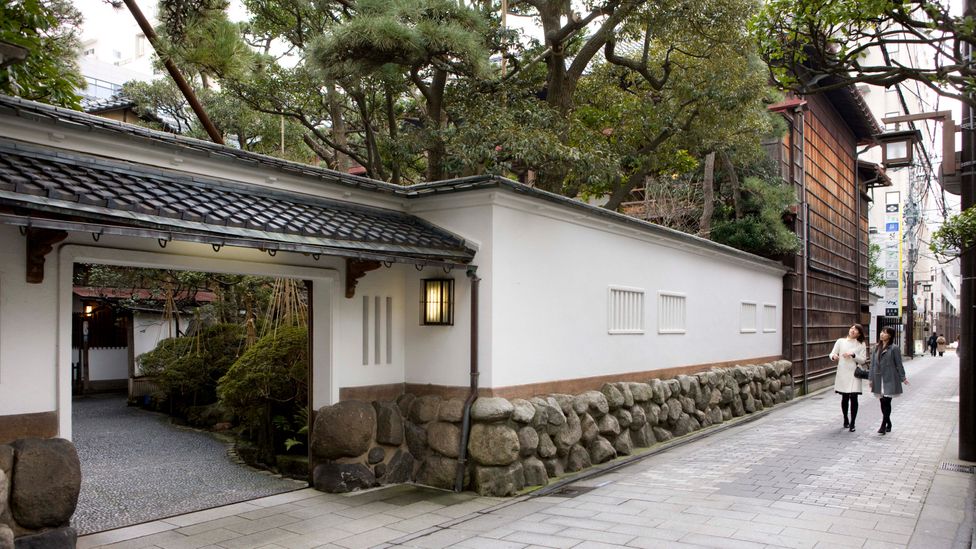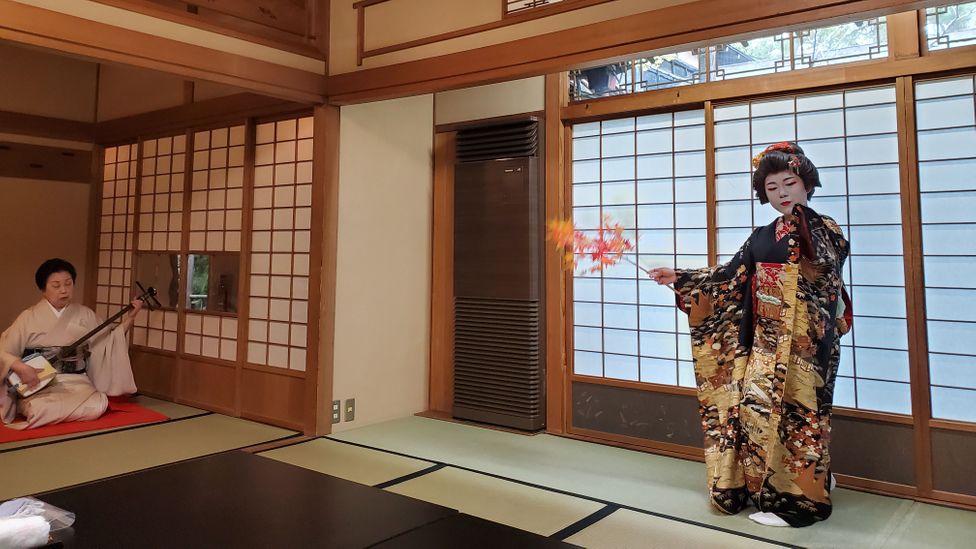(Image credit: Niigata City)

By Steve John Powell and Angeles Marin Cabello13th October 2021
For most people, the word "geisha" conjures visions of Kyoto's Gion district. But there is another major geisha centre, one that even many Japanese don't know.
The dancer glides noiselessly across the tatami mat floor, a branch of reddening maple leaves in her right hand. The long sleeves of her kimono denote that she is a furisode, or apprentice geisha. Behind her, an onesan (senior geisha) in a fawn kimono sits on the floor, plucking a lilting rhythm on a three-stringed shamisen with a large wedge-shaped pick.
A typical scene from Kyoto's Gion district, you might think. But this is more than 500km to the north-west in Niigata, a historic port city on Honshu's west coast.
Niigata's geisha tradition dates back more than 200 years to the Edo era (1603-1867) when the city was a major port on the Kitamaebune (literally, "north-bound ships") shipping route that connected Osaka with Hokkaido. Thousands of cargo vessels made this journey each year. As the capital of Japan's largest rice producing area, Niigata became the busiest port on the Sea of Japan coast. By the early Meiji Era (1868-1912), Niigata was among the wealthiest, most populous parts of the nation.
A thriving entertainment district grew up in the Furumachi neighbourhoood of the city to cater for the countless wealthy merchants and other visitors. Geishas (or geigis, in the local dialect) began performing at Furumachi's many teahouses, ozashiki (banqueting halls) and ryotei (luxury restaurants). Politicians and even members of the Imperial family figured among the clientele. By 1884, nearly 400 geigis were performing in Furumachi.
Nobuko, the shamisen-playing onesan who played the lilting song as the apprentice danced, has been a Furumachi geigi for 64 years. She recalls entertaining celebrity guests, including Prince Takamatsu, brother of Emperor Hirohito; and Kakuei Tanaka, prime minister from 1972 to 1974. Like all geishas, Nobuko is known only by her first name.

Although little-known compared to Kyoto, Niigata's geisha tradition dates back more than 200 years (Credit: Niigata Visitors & Convention Bureau)
"The prince was very friendly," she recalled. "He cracked a lot of jokes. I'm not sure whether I'm supposed to mention this, but he was playing mahjong with the senior geigis. I watched them while I served sake and tea."
While geisha activity ceased during World War Two, it quickly picked up again afterwards. Although it never regained the peak of its glory days, it still offers a fascinating glimpse into traditional formal Japanese culture and arts. Unlike the over-touristed geisha area of Kyoto, Furumachi is one of the few parts of Japan where travellers can still savour the authentic environment of a traditional hanamachi or Flower Town, as geisha districts are called.
"Today perhaps one can only experience this in Kyoto, Kanazawa [the capital of Ishikawa Prefecture] and Furumachi," said Aritomo Kubo, staff member at Furumachi Kagai Club, which helps preserve Furumachi's traditional streetscape by maintaining its heritage architecture. "Moreover, many of Furumachi's ryoteirestaurants are the original buildings, dating from the 1800s," he added.
Furumachi has the additional advantage that many of its ryotei accept first-time visitors, while many other famous geisha areas require an introduction from a regular client. Niigata is also the home of the Ichiyama School of Traditional Dance, a style uniquely practised by Niigata geigis that has been the basis of local performances for more than 100 years and is designated as an Intangible Cultural Property. Geigis perform this dance style when singing songs like "Niigata Okesa", which was brought to Niigata by mariners sailing the Kitamaebune trade route.
However, with the advent of TV, cinema and other alternative forms of entertainment, demand for geishas declined drastically. By the late 1970s, Furumachi geigi numbers had dropped below 100. By 1985, just 60 remained. With no new trainees joining since the late 1960s, the youngest geigis in Furumachi were in their 30s.
At that time, far fewer young women were interested in devoting eight years of their lives to learning the essential geisha skills: the shamisen; the songs; the dances; the manners. Consequently, the rate of new trainees failed to keep pace with the rate of retirement.
Furthermore, unlike Kyoto – the refined capital of Japan for more than 1,000 years (794-1868) – remote Niigata is a place few tourists visit, further limiting the demand for geisha performances. And by the 1980s, a lack of business forced many ryotei to close.

Visitors to Niigata can make a reservation at a ryotei in the Furumachi district to see geigis perform (Credit: Niigata Visitors & Convention Bureau)
However, things began looking up in 1987, when an enterprising company decided to help keep Niigata's geisha tradition alive. Ryuto Shinko Co, Ltd became Japan's first geigi recruitment company, aiming not just to train new geigi but also to act as intermediaries, connecting them with ryotei and other establishments. Backed by sponsorship from 80 local businesses, Ryuto Shinko contracts geigis as full-time salaried workers, providing health care and other benefits. They also hope to raise awareness and boost tourism via merchandise like T-shirts, calendars, fans and even sake bearing images of Furumachi Geigi.
Yui – the apprentice who danced across the tatami mat – is one of their recruits. "I joined after graduating from high school. This is only my ninth year," she said. "I started learning Japanese traditional dance when I was small. So I was already fond of kimonos and the sound of Japanese classical instruments."
Ryuto Shinko has introduced an attitude of innovation into the geishas' traditional world. They abolished the rule of compulsory retirement after marriage, and reached out to families, women and tourists to expand their audience from the traditional Japanese male clientele. Nowadays, Furumachi geigis dance and teach about their culture at conventions and perform at weddings and even funerals, where they perform the favourite song of the deceased. While it's quite common to see geigis on the streets of Furumachi, walking to ryoteis or to their lessons, visitors to the city can make a reservation at a ryotei restaurant to see them perform or head to one of the many annual festivals held in Niigata throughout the year.
The company has also come up with new ways to entertain modern audiences unfamiliar with geigi tradition. For example, tarukenis a game adapted from Rock Paper Scissors where customers get up and play with the geigi. The loser has to drink a cup of sake. As Niigata is one of Japan's major sake producers, taruken has the additional benefit of promoting the local brew.
Customers in the old days were regulars and knew how to lead us
"Customers in the old days were regulars and knew how to lead us," said Nobuko. "They would often start singing traditional songs, and the geigis followed their lead, playing the shamisen and dancing to their singing. This was before karaoke. Customers today are mostly new and need to be guided. Taruken is a good way to entertain them."

Yui (right) was recruited by Ryuto Shinko Co after high school and has been a geigi for nine years (Credit: Sakura PR)
However, Furumachi's fragile recovery suffered a new blow with the outbreak of coronavirus. In the months following May 2020, when the Japanese government declared a state of emergency, recommending that people avoid bars and restaurants, the number of ozashiki banquets dropped by 90%. Currently there are just 24 Furumachi geigis.
"I've experienced nothing like this. The pandemic is like an invisible war," said Nobuko, who has seen the geigi scene survive two major earthquakes. "After the earthquakes, Ryuto Shinko sent geigis out to hospitals and nursing homes to perform for free, to cheer patients up. We can't even do that now."
I've experienced nothing like this. The pandemic is like an invisible war
But then Ryuto Shinko came up with an ingeniously contemporary way of rescuing the geigis' centuries-old culture: online crowdfunding.
They set an ambitious goal of 10m yen (approx. £66,000) and a time limit of just 52 days (from 10 May to 30 June 2021) in which to raise it. Amazingly, they surpassed their goal in just 11 days, receiving 15m yen, contributed by a wide variety of people anxious to help preserve this intrinsic part of Japanese culture. They went on to collect an astonishing 30m yen (approx. £191,000).
In light of this groundswell of popular support, there are reasons to be cheerful about the geigis' future once Japan reopens to international travel.
"I feel geigis will stay the same, but our customers may change," said Nobuko. "There are many uncertainties ahead… We have to be ready to adjust to any new demand."
Whatever the future holds, Nobuko has no regrets about her career, even though it wasn't her choice. "It was my mother's idea. She had been a geigi in her hometown. I had many brothers and sisters, so I guess the reason was financial."
Nobuko remembers getting scolded frequently by her seniors in her apprentice days, but this never put her off the geigi world. "Is there any other job that gives you an opportunity to meet with so many people, including a prime minister, and talk to them as equals?" she said. "I've never been happier in my life than when I'm meeting and learning from the guests."
In light of this groundswell of popular support, there are reasons to be cheerful about the geigis' future once Japan reopens to international travel.
"I feel geigis will stay the same, but our customers may change," said Nobuko. "There are many uncertainties ahead… We have to be ready to adjust to any new demand."
Whatever the future holds, Nobuko has no regrets about her career, even though it wasn't her choice. "It was my mother's idea. She had been a geigi in her hometown. I had many brothers and sisters, so I guess the reason was financial."
Nobuko remembers getting scolded frequently by her seniors in her apprentice days, but this never put her off the geigi world. "Is there any other job that gives you an opportunity to meet with so many people, including a prime minister, and talk to them as equals?" she said. "I've never been happier in my life than when I'm meeting and learning from the guests."
You may also be interested in:
• Why Japan values 'naked communion'
• Why you've never had 'real' sushi
• Why Japan values 'naked communion'
• Why you've never had 'real' sushi
No comments:
Post a Comment